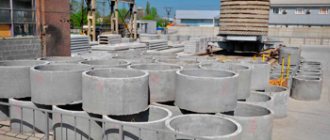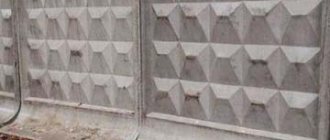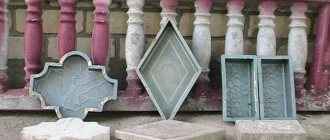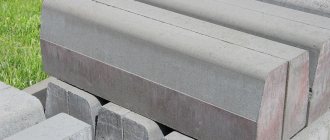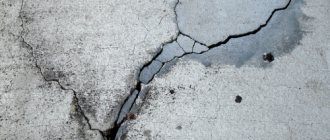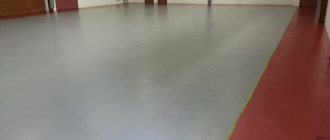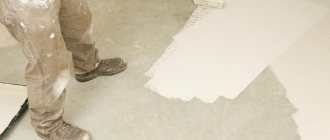Concrete is deservedly considered the most popular and oldest building material, which is made from available components - water, binding additives and a sand base. Various surfaces are finished with the solution, floors are poured, and also poured into molds for concrete products to obtain finished elements of the desired size. The mixture is evenly distributed in the matrices and hardens quickly without the use of vibropressing technology.
Concrete can be formed in many ways using concrete casting molds
Manufacturing Features
Depending on the scope of further use of the finished products, stencils for pouring concrete can be made flexible or rigid. Modern manufacturers are not limited by the choice of materials, which makes it possible to obtain a highly accurate imitation of a textured surface, as well as create any shapes and outlines. The most popular material for making matrices is plastic. It has the necessary characteristics, is resistant to alkaline compounds and is shock-resistant in operation. This is what makes it possible to obtain high-quality products.
This video shows the process of producing concrete molds:
You can buy forms for pouring concrete or make them yourself, following simple instructions. To do this, you will need the following components and tools:
- quarry, construction or river sand;
- Portland cement;
- thick garbage bags;
- construction mesh (pitch 50-60 mm);
- metal cutters;
- plastic trowel;
- large capacity;
- coloring pigments;
- adhesive tape or tape.
Cement mortar is poured into the resulting finished forms. Expanded clay, crushed stone or other polymers can be added to it, which prevent deformation of products and ensure ease of removal of products from matrices. If necessary, you can use polystyrene foam to make a single casting. From this affordable and lightweight material, a blank of the desired shape and size is cut out and filled with concrete. You can make a test stencil first , but the only drawback is the need to destroy it to remove the products.
There are several types of concrete casting molds that allow you to produce various products - tiles, figures, decorative stone, sculptures, vases, balusters, paving stones and much more. Plastic containers for fruits , confectionery or semi-finished products, as well as granules used in the manufacture of plastic containers, can be used as non-standard materials
To make paving slabs with your own hands, you can use scraps of laminated chipboard. This allows you to obtain products of square, triangular or rectangular shape.
After the concrete hardens in the mold, you will receive a part that will match the stencil
Purpose of concrete forms
Humanity first heard about cast concrete at the end of the 20th century. The main purpose of the elastic material is the final finishing of horizontal surfaces. Thanks to the mortar's ability to spread and level, the construction process has been significantly simplified; concrete casting no longer requires vibration compaction. Such material readily takes the form of a matrix and hardens quickly. Other advantages of cast concrete include :
- plasticity and ease of pouring;
- the ability to adjust the surface, which is achieved by adding substances that retain moisture;
- resistance to water penetration;
- long contact with the ground and liquids;
- insensitivity to temperature changes.
In addition, the procedure for casting figures does not require special skills from the master or the use of bulky tools.
Forms for concrete products, which experts call matrices, are containers of various sizes with an open top into which ready-made cement mortar is poured. To ensure that the product does not deform after drying and is easily removed, polymers (crushed stone or expanded clay) are added to the composition of the substance. Colored designs are obtained by adding dyes to the solution. If the mold is deep, then a rule or vibration compactor is used to compact the material.
Purpose and use of matrices
Molds for concrete products allow us to produce a wide range of products. Several years ago, the production of small-scale architectural elements used only rigid plaster, wood or steel structures. Thanks to the advent of flexible and plastic forms (made of silicone, rubber or polyurethane), it was possible to establish the production of more sophisticated and varied products. The use of concrete forms allows you to obtain:
- decorative stands;
- flowerpots and garden vases;
- balusters and railings;
- paving slabs;
- stone panels;
- concrete blocks;
- curbstone.
More complex products are produced on an industrial scale in several ways - vibrocompression or vibrocasting. During the vibrocompression process, the semi-dry composition of the mixture is exposed to high pressure and vibration flows using special equipment. With this manufacturing method, it is possible to obtain products with regular shapes and a low percentage of the water-cement part.
When vibrating casting, the liquid solution is poured into prepared rigid molds, placed on a vibrating table and left for a certain period of time. This method produces small-sized products, but human participation in the production process significantly increases the cost of the product.
Main features of artificial stone
Various materials are used to make stone decor. Their choice depends on the place where the artificial stone will be used. Thus, indoor building structures are often finished with gypsum stone. Facades are usually faced with a material made from a cement mixture and various components.
Additives include materials that make it possible to obtain a relief pattern on the finished decor. For these purposes, stone chips, sand, fine gravel, and so on are used. In production, coloring pigments in dry and liquid states are also used. With their help, stone facing material of artificial origin is given the required shades.
Artificially formed stone decor is cast in special molds or made even without their use. This distinguishes it favorably from materials of natural origin. Professionals, strictly following production technology, create artificial stone with lumpy, smooth, layered, fine-grained and other textures.
Layered texture of artificially formed stone decor Source gesso3d.ru
DIY creation
For the manufacture of large castings, it is better to use wooden formwork. It will be a big plus if the structure turns out to be collapsible, and the wood must be moistened before pouring. This method is suitable if you need to make a large batch of similar elements with outlined geometric shapes.
Homemade forms for casting concrete are quite easy to construct from wood.
In the absence of wood, rectangular or square shapes can be made using ordinary depressions in the ground. You need to pour sand into dug holes of the required size and fill them with water to moisten them. After this, concrete can be poured into the recess, covering it from above until it hardens completely.
In creating the stencils necessary for making stone or paving slabs, plastic, silicone, rubber and polyurethane will be indispensable.
Some craftsmen even use children's toy molds, creating the necessary elements in small quantities.
The main thing is to choose a container that is suitable in size. This is interesting: an alternative to concrete for pillars.
At home, it is not difficult to set up the process of producing round-shaped concrete products, for example, rings. A waste bicycle tire or tire from a stroller wheel is perfect as a mold. In addition, oval or round elements can be easily made using depressions in the ground of the appropriate shape.
To create concrete products it is not necessary to buy expensive materials. You can also make a small batch of elements using hand-made stencils. As a result, you can get non-standard options that differ from the same type of store products.
A simple way to make decorative stone
This option involves the production of artificial stone material by pouring 2 layers of the mixture into a mold. First, 3 parts of sand and 1 portion of cement are combined. Then the liquid dye is diluted with water. Its amount is usually approximately 2-3% by weight of cement. Then water with pigment is added to the cement-sand mixture until a homogeneous mass is formed, similar to thick sour cream.
The prepared solution is poured into the artificial stone matrix. It is only half full. Then the mixture is compacted and evenly distributed by shaking the mold and tapping, for example, on a table or other base on which the matrix is located.
A metal reinforcing mesh is laid on the first layer and the second part of the solution is poured, which must first be prepared without pigment. Then two lines are drawn crosswise on the surface of the mixture. They will improve the adhesion of the material during installation.
After about 12 hours, the hardened stone is removed from the matrix and dried. Then the mold is cleaned, washed and poured again.
Surface treatment methods and protection of architectural concrete
Architectural concrete becomes decorative after the concrete surfaces have undergone the final stage of the technological process - a certain processing. In addition, the treatment is used to protect the surface from external influences and aggressive environments. For this purpose, special surface preservation methods can be used, for example, fluting, hydrophobization, polymer impregnation, surface treatment with special compounds that penetrate into the concrete and clog its pores and capillaries. Such treatment increases the durability of concrete and ensures that its surface retains its appearance for a long time without special care. Processing methods are different for each type of concrete:
Industrial processing
(geometric):
- Grinding and polishing:
The dry surface of architectural concrete can not only be ground, but also further polished (this can be compared to one of the stages of the mosaic manufacturing process, when the concrete surface becomes the smooth surface of polished granite). - Sandblasting:
outwardly similar to the effect that acidification gives - the upper surface layer of concrete is washed away, creating uneven texture. - Other treatment methods:
exposure to the concrete surface through an acid-base reaction, fire treatment, epoxy (protective) coating, etc.
Using ready-made forms
(decorative):
- Stamped forms:
stamps specially made from plastic, rubber, etc., imitating various relief shapes and textures (stone, brick, slate, cobblestone, tree bark, fossils, shells and many others) are applied to the raw surface of an architectural concrete product. . - Decorative processing methods also include: stamping on the screed, translucent painting, etc.
Artistic processing
(sculptural):
- Mechanical processing of a hardened concrete surface:
many devices known for processing natural stone surfaces are used here (sharp metal tools, peaks, picks; a special hammer). - Engraving: contours and
grooves are cut into the surface of architectural concrete using tools such as angle grinders with diamond cutting discs and other tools designed specifically for cutting concrete, which imitate tiles, flagstones, geometric shapes, straight or curved lines, patterns. - Sculptural concrete:
The creation of a form occurs in the same way as in artistic modeling using a sculptural (plastic) method - creating a form from a whole piece, cutting off the excess, using the sculptural carving technique or a combined carving and modeling technique - Artistic painting:
superficial penetrating painting of a finished artistic and decorative object by a sculptor, using water-dispersed polyacrylate-based paints, using various artistic techniques.
Surface protection:
- Applying a decorative coating layer
- Sealing
- Water repellent treatment
- Dirt-, dust- and grease-repellent treatment
- Graffiti protection
- Protection from other possible influences of external environmental factors
Sculptural objects made of architectural concrete do not require special care. Indoor maintenance is limited to removing dust from the surface using a vacuum cleaner; if necessary, you can wash it with plain water and soap. To remove dust and dirt, it is possible to use equipment designed for washing cars - plain water under pressure without the use of chemically active additives. Atmospheric precipitation - snow, water - cannot cause any serious damage to any objects made of architectural concrete.
What types of concrete forms are there?
All forms can be divided into two large groups: flexible and rigid. The first ones are made from:
- silicone;
- polyurethane;
- rubber.
Rigid forms are made from:
- wood;
- metal;
- gypsum
Both types of forms must meet high tear resistance parameters, be impact-resistant and withstand increased loads.
Often, to produce complex design ideas, forms can be combined with each other.
The most popular forms for concrete are:
- wooden formwork;
- collapsible metal structures;
- frames made of polypropylene;
- plastic forms made of film;
- molds made of ABS plastic;
- flexible forms made of polyurethane and rubber.
All models differ in their advantages and disadvantages. Therefore, when purchasing, you need to focus on such parameters as ease of use and durability of the devices. Here's what we can recommend in general cases:
- If you are mass producing rectangular blocks, it is better to purchase molds made of metal that can be easily disassembled. You can easily care for them and they will have a long service life.
- If you need to make a small number of blocks or other blanks, you can use plywood molds.
- Piece decorative stones are best made in polyurethane molds. They can make products with a low percentage of defects and high reliability.
What are the benefits of plastic molds?
The constant development of technology in the construction industry makes it possible to replace metal products with plastic ones, which will have decent properties and characteristics. Here are the advantages of plastic products:
- Before pouring the solution, the surfaces of the frames do not need to be lubricated.
- There is no need to assemble and disassemble the forms.
- The products are easy to care for.
- The forms are lightweight, which makes them easy to store and transport if necessary.
Plastic frames have good properties. They are very easy to work with. They combine the best of flexible and rigid frames.
Application areas of decorative concrete
Archstone is used to perform a variety of tasks. It is most common in the design of personal plots (sculptures, fencing, small-scale architecture, etc.), the production of paving slabs, the external and internal decoration of buildings and premises, the creation of borders, steps, columns, various reliefs, etc.
Modern manufacturers offer unusual types of material. So, if during the mixing process you take glass fiber with a diameter in the range from 2 microns to 1-2 millimeters as a filler, adding 5% of the total composition of the mixture in volume, you can obtain a light transmission effect.
The material turns out to be quite expensive, such architectural concrete requires professional installation, since if it is done incorrectly, it is quite expensive to lose a structure costing about 3,000 euros per cubic meter. You can make such an archstone with your own hands.
What can be made from art concrete:
Paths
They are created in different ways: you can pour the material in a continuous layer, and then use stamps and knock out the desired design, or cast slabs and lay them in rows. To make a path, first mark the territory, remove the top layer of soil up to 10 centimeters thick, install formwork and reinforcing mesh (if necessary), fill in crushed stone, pour out the solution, and decorate it.
Fences
To construct a fence, pillars and slabs are made by casting them from mortar. Usually the surface is decorated by stamping or other methods.
Sculptures
They look very impressive and allow you to create an original look for the site. To make sculptures that are hollow inside, they first weld a frame from reinforcement, wrap it with an overlapping mesh, lay out concrete, sculpt small parts, and paint it in the desired color.
Wall decoration
It not only performs an aesthetic function, but also protects the room from external factors and insulates it. The work is carried out quite simply: the surface is cleaned of dirt and dust, dried, coated several times with primer, dried, applied with a spatula, then processed as desired.
Making decorative stone without using a mold
The production of artificial stone material is carried out not only using special matrices. It is also possible to make such decor without the help of molds. This option is very simple. Despite this, it allows you to produce original stones for cladding building structures in a private house.
Before you make an artificial stone without a shape with your own hands, you need to prepare a stencil. It is performed on ordinary oilcloth. Instead, a cardboard sheet of suitable size is often used. The dimensions of future stones are drawn on the selected material.
Although the entire process of making artificial stone decor is simple, it requires time and minimal experience in working with building materials. Therefore, it will be easier for many to purchase ready-made products and hire specialists to install them.
Decorative stone created without using a mold Source samsmogy-remont.ru
The process of manufacturing artificial stone decor is performed as follows:
- Construction plaster is mixed with water in a silicone container. Instead, you can use any container, inside of which a garbage bag is previously placed. Moreover, you can always throw it away after use.
- The stencil is protected with transparent oilcloth.
- The prepared mixture is distributed over the surface of the oilcloth within the boundaries indicated on the stencil.
- The drying gypsum mixture is given the required relief. To do this, use spatulas of different sizes.
- The drying gypsum mixture is divided into separate fragments in accordance with the markings on the stencil.
- The finished hardened tiles are removed from the oilcloth after about 15-20 minutes.
- Tiled decorative material is dried for 1 day.
Instructions for creation
The “paving stone” tile option is in greatest demand.
If you need to create large castings (curbs, curbs, piles), it is better to make the formwork from wood. If possible, the mold should be made collapsible, plus the wood should be thoroughly wetted before pouring. The method is good if there is a need to manufacture a relatively large number of similar products with a clear geometry (stone, tile, etc.).
If you do not have the opportunity to use wood, a rectangular or cube shape can be made directly in the ground, simply by digging a hole of suitable size. Sand should be poured into the holes, water should be poured on top to “lubricate” and moisten, after which they can be filled with concrete and covered from above. After the concrete has hardened, the forms can be used for their intended purpose.
To create stencils with which tiles or stone will be made, you can use any material (silicone, wood, plastic, foam, polyurethane, rubber). Everything depends only on the capabilities and imagination of the developer. Some specialists have learned to adapt even old dishes or children's molds for work, which we will discuss separately. The main thing is that the container is the right size.
If it is necessary to make a single printed casting, it can be made from foam plastic. To do this, cut out the required blank from the material, then fill it with concrete. Styrofoam is a widely available material, so you can do some preliminary testing by creating a stencil for small cubes. The only drawback of polystyrene foam is the need to destroy it to remove the concrete. But the ability to obtain a casting of any configuration, even with a three-dimensional pattern, is an undoubted advantage.
Concrete paths: strengths and weaknesses
The material from which the paths are made plays a key role. Therefore, do not forget that the convenience and aesthetics of the path will depend on the characteristics of the concrete mixture. For example, its advantages include the following points:
- affordable cost of raw materials and tools;
- durability of the constructed path;
- concrete can be reinforced with metal components to increase the rigidity and stability of the path;
- the prevalence of the material - it can be found and purchased in any city;
- it is possible to build a structure in areas with high groundwater levels;
- room for imagination in terms of design: a summer resident can fill roads of any shape and width, guided by personal preferences or inspired by architects’ designs publicly available on the Internet;
- the use of special additives makes it possible to improve the properties of the concrete mixture - increase its resistance to water, frost, temperature changes, various loads, and so on.
Disadvantages of concrete paths:
- the risk of cracks on the trail caused by soil displacement or flooding;
- the construction of permanent paths from dry concrete does not involve a simple dismantling process, so they cannot be moved to another place or removed without the use of special equipment;
- To pour the concrete solution, it must be warm outside, no rain. Also, the concrete must be completely dry before the path is ready for use;
- the procedure of mixing the components of the solution - concrete, sand, gravel and additives takes a lot of effort and time, it will be difficult to do it with a shovel, so most likely you will need a concrete mixer;
- In order to achieve the ideal appearance and high strength of finished concrete paths in a summer cottage, the installation of a formwork structure will be required during their construction. For this, the dacha owner will have to allocate time and money to purchase boards for formwork.
